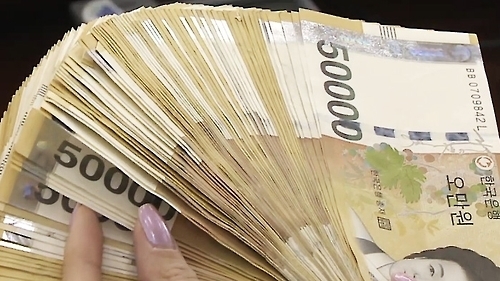South Korea’s money supply to gross domestic product ratio came to 151.5 percent last year, higher than the Organization for Economic Cooperation Development average, data from the World Bank and Korea Center for International Finance showed Wednesday.
The country’s high money supply-GDP ratio -- a measure of financial deepening -- indicates economic activity has been sluggish this year, with stagnant real estate investments and bank deposits, despite growth in the volume of currency in circulation, according to Cho Young-moo, a researcher at LG Economic Research Institute.
Money supply is categorized as M0, M1, M2 and M3, according to the type and size of the account in which the instrument is kept.
 |
(Yonhap) |
M2 includes the currency in circulation, such as bank debentures and deposits with a maturity of less than two years, and stock investments. It is closely watched as an economic indicator of money supply and possible inflation.
Korea’s M2 amounted to 2,700.4 trillion won ($2.3 trillion) as of the end of last year.
The nation’s M2-GDP ratio has made a significant jump from 131.4 percent in 2011 to 146.6 percent in 2016. It fell slightly to 146.2 percent in 2017 but quickly rebounded.
Compared to other major economies, Korea’s M2-GDP ratio was below China, Hong Kong and Japan, but above the OECD average and the US.
Hong Kong’s M2-GDP ratio came to 384.8 percent, while the corresponding figures for Japan and China were 252.1 percent and 199.1 percent respectively, in the same period.
The ratio for OECD average and the US came to 116.2 percent and 89.5 percent, respectively, in the cited period.
While Hong Kong and mainland China have maintained high, yet relatively flat levels of M2-GDP ratio in recent years, Korea and Japan have seen substantial growth.
Japan adopted a negative policy interest rate at the beginning of 2016 to combat deflation and has been maintaining the mindset since.
On the contrary, the US -- whose investors prefer stock investments over various deposit accounts offered by commercial banks -- saw its ratio fall below the 90 percent mark last year, after hitting 90.5 percent in 2017.
By Jung Min-kyung (
mkjung@heraldcorp.com)




![[Herald Interview] 'Trump will use tariffs as first line of defense for American manufacturing'](http://res.heraldm.com/phpwas/restmb_idxmake.php?idx=644&simg=/content/image/2024/11/26/20241126050017_0.jpg)

![[Health and care] Getting cancer young: Why cancer isn’t just an older person’s battle](http://res.heraldm.com/phpwas/restmb_idxmake.php?idx=644&simg=/content/image/2024/11/26/20241126050043_0.jpg)

